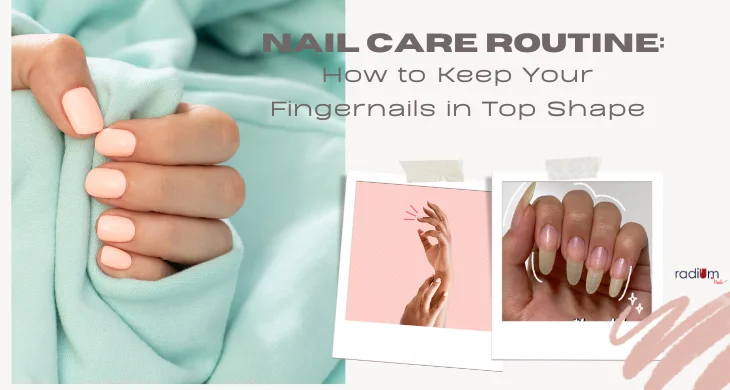Whether you’re someone who indulges in nail painting as a self-care ritual or someone who struggles with the habit of picking and biting at cuticles, we all desire well-maintained and healthy nails. Nicely groomed nails have a magical way of instantly elevating your overall appearance, and they can even impart a more youthful look to your hands.
In these times of increased hand-washing and reduced salon visits, it’s crucial to take proactive steps to care for your nails. To guide you on the path to nail health, we’ve consulted experts in the field. But before we delve into nail care, let’s understand how to identify the signs of healthy nails. Here’s what you should be observing.
Indicators of Well-Being in Your Nails:
- Your nail plates display a natural pinkish-white hue.
- You have healthy cuticles, so avoid trimming or cutting them.
- Your nails and their white tips maintain consistent and even lengths.
- There’s a noticeable, well-defined half-moon-shaped white area at the base of your nails, known as the lunula.
Indications of Nails in Poor Health:
- Nails that are peeling or prone to splitting may be suffering from dryness or a deficiency in essential vitamins.
- The appearance of tiny white spots often points to nail-biting habits or frequent nail polish application.
- Horizontal grooves on your nails could be a result of stress, elevated fevers, or accidental finger trauma.
- Redness and swelling in the skin surrounding your nails may be due to excessive cuticle removal or nail-biting.
- If your nails have a concave or spoon-like shape, it could signal a potential iron deficiency or anemia.
Here are some nail care routine tips:
- Maintain Impeccable Hand Hygiene: To start, ensure your hands are impeccably clean. Following handwashing, guarantee that your nails are entirely free from any grime. Begin by eliminating all remnants of nail polish using an acetone-free remover, which safeguards your nails from drying out. Next, apply soap to a clean toothbrush and gently scrub your nails and the surrounding skin. This will effectively remove dirt and exfoliate dead skin without the use of harsh, drying chemicals.
- Handle Your Nails with Care: Remember, your nails are quite delicate, and they deserve gentle treatment. Refrain from using metal tools beneath your nails, as excessive digging can lead to the separation of the nail plate from the skin, a condition known as onycholysis. Additionally, be cautious when cleaning with chemical substances and hand-washing dishes, as these activities can potentially weaken your nails.
- Maintain Regular Nail Trimming: Regular nail trims are just as crucial for your nails as regular haircuts are for your hair. Trimming your nails regularly not only keeps them looking neat but also reduces the likelihood of snags and breakage. Aim to trim your nails every two weeks, and adjust the frequency as needed based on how your nails respond.
- Emphasize Nail Health Rather Than Length: While long nails can be elegant, if you’ve faced issues like hangnails or breakage, it’s best to prioritize nail health over length. Consider keeping your nails short, at least for a period, to allow them to grow stronger. A shorter nail style with rounded edges not only looks tidy but is also easier to manage, reducing the risk of subjecting your nails to additional wear and tear. As long as each nail maintains a uniform shape that complements its neighboring nine, you won’t miss the extra length.
- Keep a Nail File Within Reach at All Times: If your daily activities, job, or workout routine expose your nails to potential damage, always having a nail file readily available. This allows you to quickly address any rough edges as they appear. To achieve the smoothest finish, be sure to file in one consistent direction, following the natural grain of your nail.
- Maintain Your Nail Tools: Caring for your nail tools is just as vital as cleaning your makeup brushes, as it helps prevent the growth of bacteria. To keep your nails healthy and infection-free, wash metal tools with soap and water, followed by wiping them down with rubbing alcohol for disinfection. Additionally, remember to replace disposable tools like emery boards regularly. There’s no need to persist with a worn-out tool when it’s effortless and affordable to switch to a new one.
- Be Kind to Your Cuticles: Cuticles play a vital role by sealing the area at the base of your nails, offering essential protection. Hence, it’s wise to resist the urge to cut or remove them, as doing so can compromise this protective seal, making you susceptible to bacteria and potential infections. Furthermore, it can lead to painful and unsightly tears. Tending to your cuticles also goes a long way in reducing the occurrence of those bothersome hangnails.
- Safeguard Your Nails with a Base Coat: When you’re doing your nails at home, don’t forget to apply a base coat. This crucial step not only shields your nails from staining caused by polish but also enhances the color’s richness and opacity with just a single coat. Even when opting for clear polish, “strengthening formulations create a glossy, protective layer on your nails, fortifying the tips for a thicker appearance while offering defense against damage,”. For an added touch of glamor and protection, applying a layer of clear gloss between each coat to boost shine.
- Mind the Polish Ingredients: Just like with cosmetics and skincare products, not all nail polish brands are created equal. Exercise caution and avoid nail polishes containing harmful chemicals like dibutyl phthalate, formaldehyde, and toluene. These toxins have the potential to make your nails more brittle, prone to splitting, and susceptible to cracking.
- Seal the Deal with a Top Coat for Chip Prevention: Never underestimate the importance of a top coat. This step is equally crucial, as it locks in the color of your polish and imparts a much-desired glossy finish to your nails. To keep chipping at bay, applying an additional top coat layer every three days, ensuring your manicure stays pristine for longer.
- Exercise Caution with Acrylic or Gel Treatments: Nail experts tend to advise against acrylic or gel manicures due to their potential harm to nails. However, if you’re set on getting them, there are ways to minimize the impact on your hands and nails.The primary concern with gel manicures is the exposure to UV light during the drying process, which can harm the skin surrounding and underneath the nail, increasing the risk of skin cancer. To mitigate this risk, Dr. Prystowsky suggests applying sunscreen with an SPF of 30 to 50 before the procedure to protect against UV damage. Alternatively, you can explore special gloves designed to expose only your nails, shielding the rest of your hands from harmful UV rays.
- Give your nails a break. Reserve intricate nail art and vibrant, highly pigmented colors for the weekend. During the weekdays, allow your nails to recover and rejuvenate by simply applying a clear gloss. Doctor warns that going from one strong polish color to another without giving your nails a break can dry them out, turn them yellow, and over time, even weaken the structure of the nail.
- Provide Your Nails with Some Respite: Reserve intricate nail art and highly pigmented, bold colors for the weekend, and during the week, grant your nails a chance to recuperate and rejuvenate with a clear gloss. It cautions against a continuous cycle of strong polish colors without breaks, as this can lead to dryness, discoloration (yellowing), and, with time, a weakened nail structure.
- Boost Your Protein Intake for Healthy Nails: Since your fingernails are primarily composed of the protein keratin, just as your skin’s clarity and your hair’s shine can benefit from dietary adjustments, so can your nails. It is essential vitamins and supplements like biotin, Vitamin E, and fish oil into your daily routine. Doctor emphasize the importance of protein-rich foods such as beans, fish, and nuts in your diet. The unanimous advice from experts is that finding the right combination that suits you will result in stronger and clearer nails as a reward.
FAQS:
Q1: Why is nail care important?
A1: Nail care is essential to maintain the health and appearance of your fingernails. It helps prevent issues like brittleness, breakage, and infection while promoting overall nail health.
Q2: How often should I trim my nails?
A2: Regular nail trimming is recommended every two weeks, but the frequency can vary based on how fast your nails grow and your personal preferences.
Q3: Should I cut or push back my cuticles?
A3: It’s best to avoid cutting your cuticles as it can lead to infection. Gently push them back to maintain a clean nail appearance.
Q4: Are there specific products I should use for nail care?
A5: Using a gentle nail brush, acetone-free nail polish remover, a fine-grit nail file, and cuticle oil or cream are essential products for a nail care routine.
Q5: How can I prevent nail polish from staining my nails?
A5: Using a clear base coat before applying nail polish can help prevent staining. Regularly changing nail polish colors and giving your nails breaks from polish can also prevent discoloration.
Conclusion:
Maintaining a nail care routine is not just about aesthetics; it’s a fundamental aspect of overall self-care and health. Your fingernails, composed of keratin, deserve the same attention and care as your skin or hair. By following the expert tips outlined in this guide, you can achieve and maintain healthy, strong, and beautiful nails.
From gentle cleaning and regular trimming to nourishing your cuticles and using the right products, these practices can make a significant difference in the condition of your nails. Remember to be mindful of your nail health, give your nails a break from time to time, and avoid harsh treatments like acrylic or gel manicures unless used sparingly.

